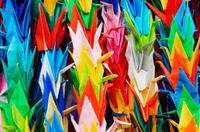Hiroshima Peace Memorial Park and Miyajima Island Tour from Hiroshima
Hiroshima, Japan
Rating: 









Trip Type: City Tours
Duration: 7 hours
Explore World Heritage sites in Hiroshima and Miyajima in one day! Miyajima is famous for its Itsukushima Jinja Shrine. Its red torii gate appears to be standing in the sea during high tide. Walk through the Hiroshima Peace Memorial Park, dedicated to promoting peace around the world.
More About This Activity All City Tours →
Explore World Heritage sites in Hiroshima and Miyajima in one day! Miyajima is famous for its Itsukushima Jinja Shrine. Its red torii gate appears to be standing in the sea during high tide. Walk through the Hiroshima Peace Memorial Park, dedicated to promoting peace around the world.
Miyajima (literally 'shrine island') has been celebrated as a sacred island and one of Japan's three most scenic views. It is most famous for Itsukushima Shrine, which, together with its large wooden torii (gate), stands in the ocean during high tide. Deer move around the island freely, and so do monkeys on top of Misen, the island's highest mountain.
The Hiroshima Peace Memorial Park was built to commemorate the dropping of the atomic bomb over Hiroshima on August 6, 1945 and to promote a peaceful world. It is located in the area around the atomic explosion's epicenter, and houses the Peace Memorial Museum and many other related monuments.
The Peace Memorial Museum graphically displays the atomic bomb's horrible effects on the city and its inhabitants. A visit is naturally depressing. In the museum's east building, Hiroshima's militarist past and the process leading to the dropping of the bomb are documented. Audio guides are available in more than a dozen languages.
The Atomic Bomb Dome is one of the few buildings around the explosion's epicenter that partially survived the blast, and the city's only remaining bomb damaged building.
Between the museum and the Atomic Bomb Dome stands the Memorial Cenotaph for Atomic Bomb Victims. It contains a list of all the people who were killed by the explosion or died due to the bombing's long-term effects such as cancer caused by radiation. The Statue of the A-Bomb Children and the Cenotaph for Korean Victims are some of many more monuments found in the park.
Miyajima (literally 'shrine island') has been celebrated as a sacred island and one of Japan's three most scenic views. It is most famous for Itsukushima Shrine, which, together with its large wooden torii (gate), stands in the ocean during high tide. Deer move around the island freely, and so do monkeys on top of Misen, the island's highest mountain.
The Hiroshima Peace Memorial Park was built to commemorate the dropping of the atomic bomb over Hiroshima on August 6, 1945 and to promote a peaceful world. It is located in the area around the atomic explosion's epicenter, and houses the Peace Memorial Museum and many other related monuments.
The Peace Memorial Museum graphically displays the atomic bomb's horrible effects on the city and its inhabitants. A visit is naturally depressing. In the museum's east building, Hiroshima's militarist past and the process leading to the dropping of the bomb are documented. Audio guides are available in more than a dozen languages.
The Atomic Bomb Dome is one of the few buildings around the explosion's epicenter that partially survived the blast, and the city's only remaining bomb damaged building.
Between the museum and the Atomic Bomb Dome stands the Memorial Cenotaph for Atomic Bomb Victims. It contains a list of all the people who were killed by the explosion or died due to the bombing's long-term effects such as cancer caused by radiation. The Statue of the A-Bomb Children and the Cenotaph for Korean Victims are some of many more monuments found in the park.
« Go Back

